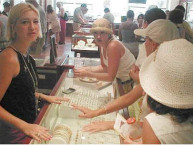Amber
Amber is ancient tree resin used for jewelry, decoration, medicine, and perfume. Specimens with inclusions of insects and plants are important for scientific study. Amber with organic inclusions is highly valued by collectors.
Amber is an organic gemstone, meaning that it was once part of a living organism. In the case of Amber, it is the resin of trees hardened over a period of around 40 million to more than 300 million years through a process called polymerization. This converts the soft, sticky resin into a harder material that can easily be cut and polished.
Tree resins that have not fully undergone the full polymerization is known as copal and is often marketed as “amber”, or euphemistically as “young amber”, but the term Amber should be limited to the fully polymerized resins.
Gemological properties of Amber
Color: Yellow, white, red, green, blue, brown, black
Transparency: Transparent, Translucent, Opaque
Luster: Resinous
Crystal system: Amorphous
Hardness: 2 – 2,5 (Mohs scale)
Specific gravity: 1,07 ±0,03
Refractive index: 1,54 ±0,04
Birefringence: None
Optical character: Isotropic
Cleavage: None
Fracture: Conchoidal
Chatoyancy: Possible
Fluorescence (Long-Wave UV) Moderate to strong chalky blue to yellow/green
Treatments of Amber
Heat is the most common treatment of Amber. Amber containing numerous small gas bubbles will have a cloudy or hazy appearance. Gentle heating and slow cooling will diffuse the gas and greatly improve the clarity of the Amber. Heating with rapid cooling produces small internal discoid fractures called “sun spangles” These are quite attractive and very popular. Amber can be buried in sand and slowly heated over a long period of time to darken the color, giving it an antique look.
Other treatments are dying to change the color; coating the Amber to harden it, brighten the polish or add a texture; and “foiling:.. placing foil or colored paper in the setting under a cabochon to add visual appeal or alter the apparent color.
As with all gemstone treatments, disclosure at the time of sale is mandatory. Failure to disclose treatments is considered fraudulant.
Identifying Amber
Amber may be confused with other materials, primarily plastic or glass.
The easiest first step is to place in Amber in a strong saline solution or in sea water. Amber will float, plastic and glass will sink.
A second test is a hot point. Heat a pin, needle or nail to red-hot and lightly touch the stone in an inconspicuous place. This test should be used with care and must be considered as destructive. If the material quickly vaporizes and emits a pine resin odor, it is most likely Amber. If it is difficult to vaporize or melt and has a petroleum smell, it is plastic. Glass will be untouched and will not have an odor. It should be noted that reconstituted Amber will behave the same as natural Amber.
Imitation Amber
One common imitation of Amber is made from Amber itself. Small pieces of Amber can be melted to produce a large block of Amber to allow consistent, calibrated cuts or to create larger sculptural items. The is called Reconstituted Amber and may be sold under a variety of trade name, Often small amounts of dye will be added to improve color. Sometimes you may see reconstituted Amber with chunks of amber or plastic imbedded to give a more natural appearance. Close examination may reveal elongated bubbles or swirling flow lines. Imbedded chunks are usually fairly obvious and may have very straight sawn edges.
Plastic is a widely used imitation. It is often found in beads, particularly round shaped. Deep red plastic Amber imitations were very popular from 1940 through the 1960s. You may find plastic imitations complete with included bugs and even larger animals. In Mexico, one of the more abundant imitations contain scorpions or lizards, virtually impossible to find in the natural world.
Copal vs Amber
Copal, sometimes called young or immature Amber is resin that has not fully polymerized. Unfortunately, Copal is often sold as Amber. Copal from Colombia is very popular at most mineral shows and usually contains bugs or plants. Copal is beautiful and fascinating in its own right, but should never be called Amber.
There are two ways to separate Amber from Copal. The first is to place a small drop of Acetone or any other strong organic solvent on the material. Copal will soften and become sticky of as little as 2-3 seconds. Amber will remain hard and unaffected. The second method is to use a sharp knife or scalpel to attempt to carve a small slice from and edge of the material. Amber will chip or crumble. Copal will produce a small slice or peeling.
Sources of Amber
Amber may be found almost anywhere in the world. The most common sources of Amber are The Baltic Sea, The Dominican Republic, Myanmar. Russia, Mexico and Indonesia.
Baltic Amber is prized for its abundance and ability to be fashioned into gemstones. Dominican Amber is known as a source for insect inclusions.
Blue Amber, caused by strong fluorescence, can be found in Indonesia and The Dominican Republic
Amber Jewelry
 The use of Amber in jewelry dates back over 13,000 years, making it one of the oldest ornamental stones in human history. Today, Amber jewelry set in silver is popular. Traditional natural motifs incorporating leaf and flower designs in silver are common in Polish Amber Jewelry and Russian Amber Jewelry. Modern designers use Amber in striking designs often using other materials such as Jet, Black Jade or wood.
The use of Amber in jewelry dates back over 13,000 years, making it one of the oldest ornamental stones in human history. Today, Amber jewelry set in silver is popular. Traditional natural motifs incorporating leaf and flower designs in silver are common in Polish Amber Jewelry and Russian Amber Jewelry. Modern designers use Amber in striking designs often using other materials such as Jet, Black Jade or wood.
Amber Beads
Amber beads are always in demand. A variety of sizes and shaped are drilled and strung on thread for necklaces. They can be found as small tumble polished chips, creating a very textured look. Larger pieces of Amber may be tumbled and polished into beautiful nuggets. Very large chunks of Amber up to 3-4 inches in diameter, sometimes called “potato Amber” are hand polished.
Amber is also cut and polished in a variety of shapes, including round, oval, lozenge, barrel, roundels, and almost every other bead shape imaginable. Sometimes they are faceted as well.
Because of Amber’s very low specific gravity, even the largest of beads and nuggets are light enough for comfortable wearing.
Amber with insects
 Amber is unique in the mineral world because it may contain animals or plant matter that became caught in the resin as it was secreted. Typically the animals are small insects. Flies, gnats and ants are the most common. These remains are not fossilized, meaning they have not been replaced by stone. Instead they are the actual plant or insect preserved intact. They are immensely valuable to the scientific community for the study of ancient life forms. Insect inclusions are in high demand among collectors. Large or rare insects can be quite valuable. In very rare pieces, small lizards, frogs and very small mammals may be found. Inclusions in Amber contain their original DNA. The Jurassic Park movies are based on extracting the DNA of larger animals from remnants of bloods inside trapped mosquitoes. Insects inclusions in Amber are usually found as freeform polished loose stones but occasionally may be found in jewelry.
Amber is unique in the mineral world because it may contain animals or plant matter that became caught in the resin as it was secreted. Typically the animals are small insects. Flies, gnats and ants are the most common. These remains are not fossilized, meaning they have not been replaced by stone. Instead they are the actual plant or insect preserved intact. They are immensely valuable to the scientific community for the study of ancient life forms. Insect inclusions are in high demand among collectors. Large or rare insects can be quite valuable. In very rare pieces, small lizards, frogs and very small mammals may be found. Inclusions in Amber contain their original DNA. The Jurassic Park movies are based on extracting the DNA of larger animals from remnants of bloods inside trapped mosquitoes. Insects inclusions in Amber are usually found as freeform polished loose stones but occasionally may be found in jewelry.
Caring for Amber jewelry
Because Amber is soft and brittle, great care needs to be used when wearing Amber jewelry, especially set in rings. Treat it gently and avoid rough handling and harsh environments.
Don’t wear Amber while working in the garden, cooking, cleaning the house, doing dishes or laundry
Amber is sensitive to heat. Even though it looks beautiful on that sunny windowsill, direct sunlight can discolor or fracture Amber.
Always apply perfume or hairspray before putting on Amber Jewelry.
Do not store in a drawer or box with other jewelry unless wrapped in a soft protective cloth.
Gently clean Amber jewelry with a soft flannel cloth and very mild soapy solution.
A soft cloth with a drop of olive oil can brighten the polish.
If the Amber is scratched or damage, take it to an exert for repair, don;t try it yourself/
Ornamental Amber
Because it is soft and easy to carve or shape, Amber has been used for ornamental purposed for centuries. Since it is soft and easy to hold between teeth is traditionally used for mouthpieces in tobacco pipes, bagpipes and glass blowing.
Because Baltic Amber contains Succinic Acid, a natural analgesic, some people believe babies should wear an Amber Bead necklace for teething purposes. However, there is no proof that the Succinic Acid is released in the baby’s mouth and there is a significant risk of choking; so this use is not recommended.
Amber is used in sculpture, either as the primary sculptural material or inlaid as accents. Another use, dating back a few centuries, is a handle for cutlery, knives and shaving razors.
The Amber Room
Perhaps one of the most amazing uses of a gem material in a building interior was the legendary “Amber Room.” Created in the eighteenth century, this work of art was for King Frederick William I of Prussia.
Its baroque style, it featured wall panels of various sizes in different shades of Amber, inlaid with intricate carvings. Doors and windows were framed in Amber, and ornate showcases were filled with small, precious amber objects. Shiny plaques of red amber glowed in sharp contrast to the yellows and browns.
Frederick gave it to Czar Peter the Great of Russia him as a gift. The Czar had it dismantled, carefully packed, then hauled by sleigh to his Winter Palace at St. Petersburg. In 1755, Peter’s daughter had the rooms panels transferred to the summer palace outside of St. Petersburg. As late as 1763, craftsmen were still making additions to the prodigious creation, which stayed in Russia into the twentieth century.
Dismantled for protection during World War II, most of the carvings were lost or stolen. It is doubtful that the original room will ever be found and re-assembled.
Amber legends and lore
Amber has fascinated humans for centuries, an ancient name for amber, lyncurius or “lynx stone” arose from the belief that amber was made from solidified lynx urine.
The Chinese believed that Amber was made from the souls of tigers, entering the earth when the animals died. American Indians found Amber stones floating in the lakes and felt these were bits of the sun fallen to Earth. Another name for Amber was electrum, from which we derive “electricity”, because Amber provided the earliest demonstrations of static electricity.
In Norse tradition, it was claimed that the tears of the Goddess Freya became Gold when they fell upon the Earth and lumps of Amber when they fell into the sea. Many myths associated amber with the sun and with immortality from the suns perpetual rebirths.
Romans considered amber nodules so protective that they hung them on nets that defended the podium against wild beasts in the amphitheater. Roman gladiators hung amber on their weapons and armor. Pliny said that a small figurine of amber was thought more valuable than a healthy slave.
Metaphysical properties of Amber
Amber, being an organic material, contains the essence and energy of life itself. No other gemstone can match its ability to resonate with the Universal Lifeforce.
Amber is a can be thought of as a chakra cleanser.. It may absorb negative energy, helping to rebalance your energy flow. Amber has a gentle, soothing effect.
Amber accentuates decisiveness. It strengthens helps with emotional calming and centering. It is an excellent grounding stone, and transmutes negative energy to positive. Amber radiates a warm and bright energy.



